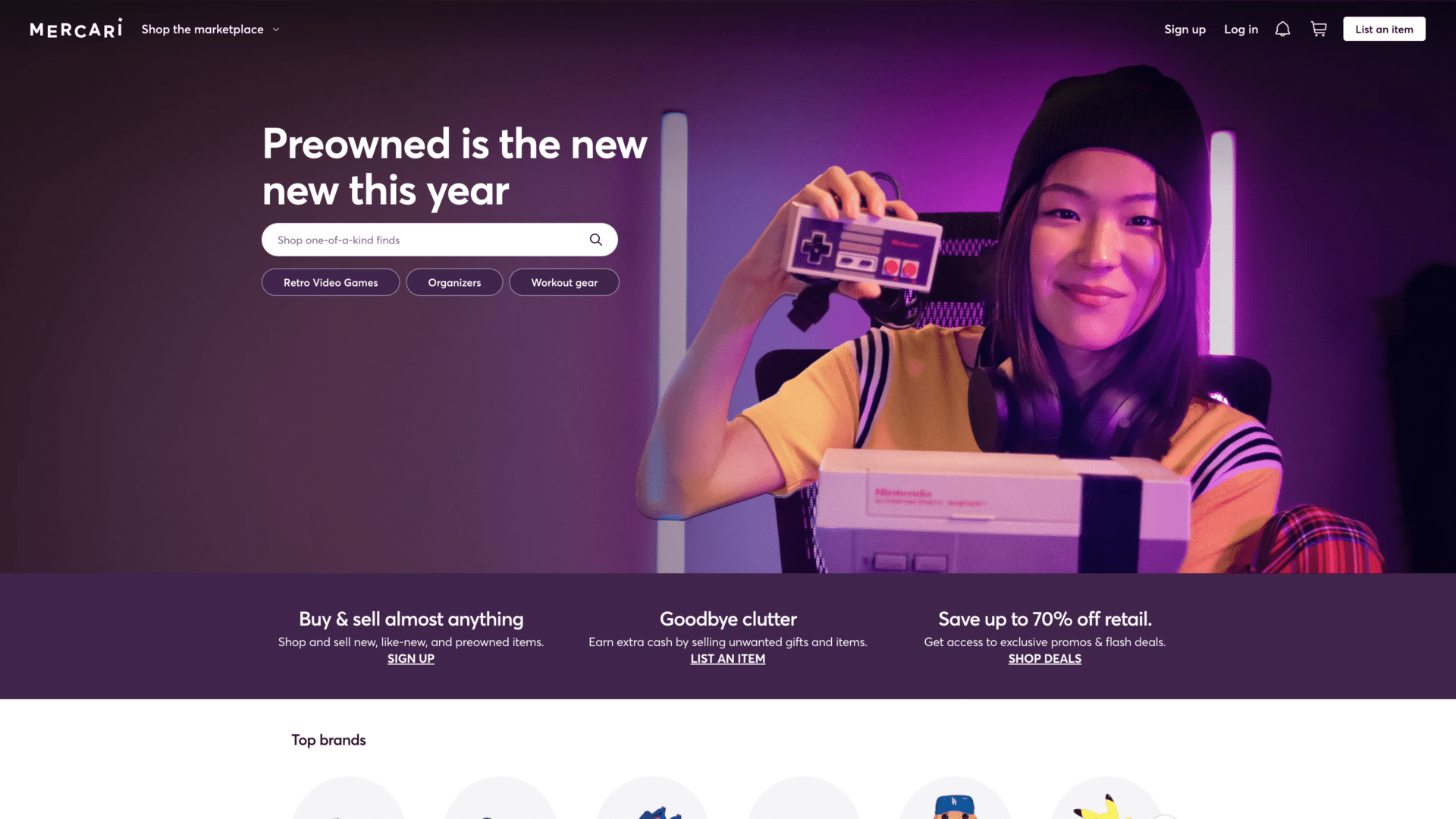Do you have items you no longer use or wear but keep because you’re unsure what to do with them?
So do most people! In fact, an estimated 80% of belongings are held onto but remain unused.
Want to resell? Websites that act as resale platforms allow you to curb your clutter and earn some extra cash!
This guide will tell you what you must know about these platforms, including important elements like sales tax, shipping costs, and seller fees.
We’ll also recommend a few of the most popular resale websites to use.
Resale Websites: What You Need to Know
Before examining the top reselling websites for online sales, here’s an overview of resale platforms and how they work.
What Is a Resale Platform?
A resale website or platform is a vehicle for selling items and generating a profit.
You can find a marketplace to sell almost any item you want removed from your closet or storage unit. For example, you would use a platform like Depop to sell clothing and footwear.
Some people use reselling to empty their closets and drawers, providing an excuse to stock up on new clothes.
Others make it into a side hustle or even a business, although that requires having a large supply of covetable items.
How Does a Resale Website Work?
Here are the steps you need to follow to earn through a resale site:
Step 1: Select the Item for Sale
Choose the item you’d like to place for sale. The item should be in good condition to inspire consumer interest. You can increase your earnings potential by selling a popular item.
Step 2: Take Photos of the Item
Next, showcase your item by snapping photographs. Take images in bright, natural lighting to display the natural color range of the product.
Buyers want to see products from the front, back, and sides. Don’t ignore any angles when photographing your product.
Used items are rarely perfect. Don’t shy away from showing minor flaws or defects. For example, a vintage T-shirt might have a small hole along one seam, or an action figure could have yellowed packaging due to age.
Step 3: Write a Product Listing
Visuals will sell your product, but you must also write a description of the item.
Include information such as how long you’ve had it, the condition, and if the item was stored in a smoke-free and pet-free home.
You can also share your return policy.
Step 4: Post the Listing
Reread your description and double-check the photos, looking for any typos or image upload errors. Make your listing live when you’re ready.
Your item is now officially for sale on the online marketplace.
Step 5: Wait for a Buyer to Purchase
The hardest part is waiting for a buyer to show interest in your listed item. You could wait hours, days, or weeks for a willing buyer. The more value the item holds, the faster it will sell.
Step 6: Get Paid
You will receive payment when the item sells, or the buyer’s item is delivered. The payment will come from the resale site in the format you select, such as direct deposit or through a third-party payment platform.
Step 7: Ship the Item
The buyer expects their item soon after their purchase. Carefully package it up and take it to your local mail service to send it. Request shipping information to forward it to the buyer.
What Do You Pay to Sell Stuff Online?
The money you make when using a resale site isn’t all profit. You’ll have to pay fees, as when you resell websites ask for a portion of your earnings. These fees include:
Listing Fees
Some eCommerce platforms, such as eBay and Amazon, charge users a listing fee to post their products on the site.
eBay charges a final value and insertion fee. The resale giant calculates the final value based on what you earn through the sale. The insertion fee is a nonrefundable charge determined by product quantity and category.
Amazon issues a listing fee for monthly storage and fulfillment. Users selling large quantities of goods on Amazon might borrow the company’s warehouses to store them, which explains the monthly storage charge. The fulfillment fee varies based on the item’s size and weight.
Transaction Fees
A transaction fee is often referred to as a referral fee or seller fee. The amount is typically a couple of dollars or less for every item sold. You won’t pay a transaction fee if you sell items locally.
Shipping Costs
Buyers typically pay the shipping cost, which varies depending on whether the buyer selects domestic or international shipping.
The resale platform calculates the shipping fee before checkout.
The Best Resell Websites in 2023 (With Pros and Cons)
Are you ready to begin selling goods through a resale website? This section will examine the most popular options, with pros and cons, to help you choose which site to begin listing your items.
1. eBay

eBay is one of the most popular resell websites, rising from a platform for buying used items in the mid-1990s to a multi-billion-dollar enterprise in the 2020s. The site has never discriminated against what users can sell, offering every product imaginable.
You have to pay an insertion fee to put a listing on eBay and a selling fee when a buyer purchases your item.
You receive 250 free insertions per month. If you surpass that number, you must pay per category and listing.
eBay charges an insertion fee for relisting a product, such as if it expires without anyone bidding on it or purchasing it. However, you don’t have to pay more than one fee for a listing with multiple items.
Pros
- Name value: eBay has been a household name for decades, proving it has staying power as other sites of its generation have come and gone.
- Trustworthiness: A brand like eBay commands trust. Sellers feel confident reselling their goods on the platform, and eBay’s guarantees protect buyers.
- Versatility: eBay is a general resale website that doesn’t limit what you can list on the platform. You can sell stuff online, like clothes, movie memorabilia, gardening supplies, food, skincare, and more.
Cons
- Insertion fees for items that don’t sell: eBay may have a generous insertion fee, with 250 free credits a month, but you must pay an insertion fee to relist an item if it doesn’t sell.
2. Facebook Marketplace

Social media giant Facebook created a resale app called Facebook Marketplace. You can connect with buyers through your Facebook profile, selling locally to those in your neighborhood or shipping orders to faraway customers.
Facebook Marketplace takes a page from eBay’s book, allowing users to search for any item they want to acquire. The available categories list is vast, making it a popular resale option.
You can connect an existing Shopify store to Facebook. Meta, which owns Facebook, charges a processing fee for onboarding a Shop to the Marketplace’s Commerce Manager. The fee is 2.9% for credit card purchases, 3.49% for PayPal checkout, and 2.9% for Shop Pay.
Pros
- Account convenience: You don’t have to create a new account to begin selling on Facebook Marketplace.
- Bank payments: Facebook sends payments directly to your bank account.
- Shipping cost freedom: You can roll shipping fees into the item cost when selling on Facebook.
Cons
- Not always safe: Meeting up to drop off local goods sold on Facebook Marketplace can put buyers (and sellers) in dangerous situations.
3. Depop

Depop is a fashion haven. Sellers can list jewelry, footwear, and beauty products as well as clothes on the site.
Depop was founded in 2011 in Italy. Etsy purchased the platform in 2021, although Depop continues to operate outside of Etsy.
You must pay a 10 percent selling fee to use Depop, which the platform takes from your Depop Payments amount or PayPal.
Depop sends payments for resold products directly to your PayPal account, where you can keep it or transfer it to your bank account. You can also receive payment through credit or debit card or Apple Pay.
Pros
- Large audience: Depop’s audience has grown to include worldwide customers, ensuring you reach a large base of buyers when you list fashion products on the platform.
- Product promotions: Increase interest in your listing by promoting it on social media.
- Secure app: The Depop app is secure, inspiring more sellers to use the app (or website) and purchase your goods.
Cons
- Non-enforced rules: Users have expressed confusion at Depop’s rule system, which seems to be enforced arbitrarily and can impede selling.
4. Etsy

Handmade goods live on Etsy. It specializes in craft tools and supplies, toys, furniture, décor, and clothing, with quite an expansive range. You can find vintage items on Etsy that are 20 years or older, but newer goods are also available.
Etsy charges listing, transaction, promotional, and advertising fees if you use offsite ads or Etsy Ads. The transaction fee is 6.5 percent of your item price, gift wrapping, and/or shipping costs. Listing fees are $0.20.
Etsy Payments is the platform’s service for paying its sellers. Alternatively, you can use PayPal, as Etsy Payments isn’t available worldwide.
Pros
- Growing audience: Etsy has 96 million active users and counting. Some like the vintage atmosphere of the platform, but others also use it to buy new goods.
- Low fees: The fee to list items on Etsy isn’t expensive. You should always earn back what you spent when you sell your item.
- Mockup photo generators: Etsy’s sophisticated technology, such as mockup photo generators, make it easy to produce product image renders to begin selling items fast.
Cons
- Growing competition: A larger user base means more sellers have flocked to Etsy. The increase in competition makes it more difficult for sellers to stand out.
5. Mercari

Mercari was created in Japan in 2013. The marketplace sells goods from major brands like Apple and Nike. Buyers can find everything from Funko Pops and smartphones to video games, clothing, collectibles, and holiday decorations.
Mercari only charges for items you sell, and the rate is 10 percent of the item value. Mercari pays sellers through Instant Pay or direct deposit.
Pros
- No listing fee: Mercari allows sellers to list their goods for free. That’s a big advantage over other resale sites.
- Free, easy signups: You’re in good company if you join Mercari, as many users have signed up for this free service to list secondhand or resold items.
- Smart pricing: Mercari has a smart pricing feature to help you select a fair, appealing price for the products you list on the site.
Cons
- Frequent returns: Mercari allows users to return items for free. Some buyers purchase an item only to return it, leaving sellers in the lurch.
6. Poshmark

Poshmark is known for secondhand clothing and fashion, but the site also sells electronics and home goods. Founded in 2011, Poshmark has grown to encompass an 80+ million user base, with millions of listings available.
The service takes a flat commission fee of $2.95 if your item costs less than $15. The fee is 20 percent for items over $15, leaving you with 80 percent of the profit.
Poshmark pays users directly to their accounts 3 days after the product is delivered to the buyer. You can transfer the money to your bank account, Venmo, or PayPal. You can also ask Poshmark to send you a check.
Pros
- Item sharing: Poshmark allows users to share listings within the platform. You can also post your latest goods for sale on any social media site.
- Easier shipping: After the buyer pays the fixed price for shipping, Poshmark sends the shipping label to you. You don’t have to obtain it, saving you a step.
- Special deals: Poshmark deal days like “Love It or List It” and “Closet Clear Out” reduce the prices of goods on the platform. Your items could generate attention during these events, even if your online shop had sluggish sales before.
Cons
- Oversaturated: Poshmark’s millions of listings mean sellers must work harder to generate income, including sharing listings on social media.
Frequently Asked Questions
Do you still have questions about using a resale app or website?
This FAQ section will help you get started.
What Should My Final Sale Price Be for Used Items?
Determine the selling price of your items by using the 50-30-10 rule. Items in the worst condition should sell for 10 percent of the retail price. Used items in average condition should have a sale price of 30 percent of the original value and lightly used items of 50 percent.
Following this pricing methodology should help you earn a profit despite selling fees.
How Much Money Can You Make Using Resale Websites?
Your resale earnings depend on the selected sale price, seller fees, the value of the item you sell, its popularity, rarity, and condition. The quantity of used items you have to sell also impacts your profits.
Should I Accept Haggles?
Haggling is common for used and resold items on and off the online marketplace. Certain websites have haggling built in, like eBay’s bidding system. Others require you to message the seller and try to drive them down.
You might consider accepting a haggle if the offer is close to the sale price and few other buyers have expressed interest.
Wrapping Up
Resale websites offer big-ticket items, vintage clothes, and designer items. The best platform to sell your goods should have low fees, an excellent reputation, and a large user base.
Have you used resale sites before to sell stuff online? What was your experience like?
Let us know in the comments below and share this article if you enjoyed it and learned something new!









